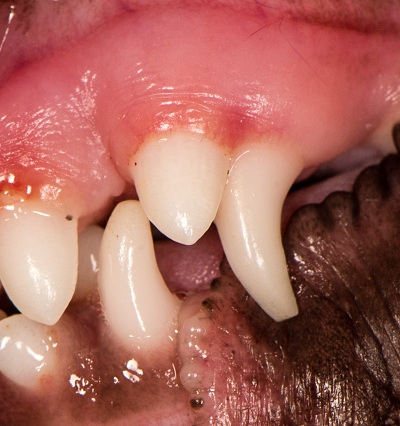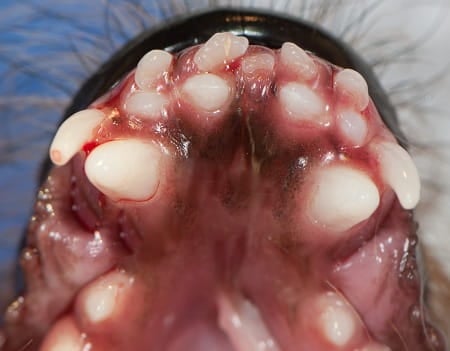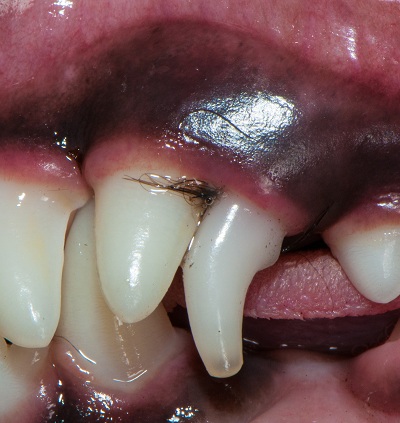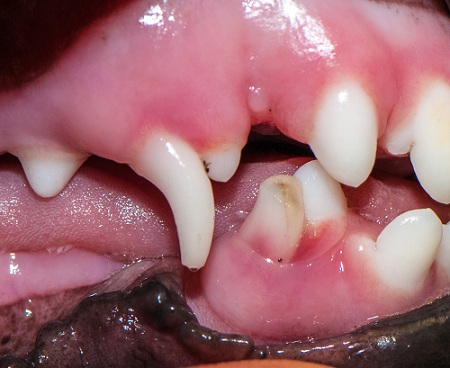How Much Money to Remove a Dog Baby Tooth
How many sets of teeth do dogs have?
As in humans, dogs accept ii sets of teeth in their lifetime. Puppies have 28 deciduous teeth besides known as chief, baby, or milk teeth. Adult dogs accept 42 permanent teeth, also known as secondary teeth.
When do puppies go their deciduous teeth?
Puppies are built-in without any visible teeth. The deciduous teeth offset erupting through the gums effectually three weeks of historic period and typically by six weeks of historic period all the deciduous teeth are present.
A healthy oral fissure depends on healthy teeth. The platonic fourth dimension to brainstorm brushing a puppy's teeth begins as before long as you bring your puppy home. The gums are sensitive when teeth are erupting so gentle cleaning during this fourth dimension is important. Your veterinary health intendance team can help you decide the best products and methods of dental care for your puppy.
When practise puppies go their permanent teeth?
In puppies, the entire teething process is relatively rapid. Teething begins in puppies at virtually 3½ to 4 months of historic period, when the deciduous incisors begin to exist replaced by permanent incisors. Past the age of 6 to 7 months, most puppies have all of their adult teeth.
What happens during teething?
Long before developed teeth erupt through the gums, they begin developing from molar buds located in the upper and lower jaws. As the adult teeth develop, they begin to exert force per unit area against the roots of the deciduous teeth, stimulating the roots of the deciduous teeth to brainstorm resorbing. Once the roots have resorbed, the crowns of the deciduous teeth fall out. You may fifty-fifty observe these hollow shells of babe teeth on the floor or in your puppy's bedding, but very oft they are swallowed while your puppy is eating to no sick effect.
"Long earlier adult teeth erupt through the gums, they begin developing from tooth buds located in the upper and lower jaws."
During the teething process, your puppy may drool, may exist reluctant to consume as robustly as usual, and may be irritable due to a tender mouth. Nigh all puppies have the urge to chew when they are teething. Information technology is important that you practise what you can to direct your puppy'southward chewing towards acceptable and condom objects. Practise non allow your puppy to chew people's shoes, dress, or the furniture. Avert hard toys, nylon chews, cow hooves, and ice cubes equally they tin can damage the teeth. Avoid feeding your puppy bones (cooked or otherwise), as they are as well too hard to chew and can result in damaged teeth and intestinal damage if swallowed.

You may also notice a characteristic jiff olfactory property, known as 'puppy breath', which is associated with teething. This odor is normal and will concluding as long as the puppy is teething.
What is a persistent molar?
When a deciduous tooth is still present at the time that the permanent tooth has begun to erupt, it is referred to as a persistent tooth. When this happens, the infant tooth occupies the place in the rima oris that is meant for the permanent tooth, forcing the permanent tooth to erupt in an aberrant position. The end result is crowding of the teeth and possibly even an abnormal contact of the teeth with either teeth and/or the soft oral tissues. Malpositioned teeth result in an abnormal bite.
Which deciduous teeth are more commonly retained?
The most common persistent teeth are the upper canines, followed by the lower canines and so the incisors. Notwithstanding, whatever deciduous teeth could be persistent.
Persistent teeth are likewise more common in small breed dogs, and in brachycephalic breeds (dogs with curt noses or flat faces), such equally Bulldogs, Pugs, Boston Terriers, and Boxers.
There may too exist a genetic predisposition to developing persistent primary teeth as it frequently occurs in families of dogs.


What problems are caused by persistent deciduous teeth?
The crowding that results from the persistent molar and its permanent analogue will increase the likelihood that food and debris will become trapped between the teeth. An increased tendency to accumulate food debris and plaque can atomic number 82 to issues such equally tartar deposits, gingivitis, and ultimately periodontitis. Additionally, if there is traumatic contact of teeth with other teeth or with the oral soft tissues there will be pain and infection. Teeth contacting other teeth inappropriately tin lead to abnormal habiliment and weakening of the teeth with subsequent molar (or teeth) fracture.
Occasionally, a persistent deciduous tooth tin cause a dental interlock which may interfere with the normal growth and development of the jaws.
If the persistent deciduous molar is a lower canine, the permanent lower canine is forced to erupt on the inside of the persistent deciduous molar and as the permanent tooth erupts information technology will contact the roof of the mouth causing pain and impairment which makes it difficult for your domestic dog to eat.
When and how are persistent teeth treated?
Equally a general dominion, no two teeth should be in the aforementioned place at the same time. If you notice a persistent deciduous tooth in your puppy's rima oris, schedule an engagement as soon as possible with your veterinarian. Typically, persistent deciduous teeth need to be removed (extracted) promptly in lodge to avoid the secondary problems that occur with the erupting permanent counterpart.
"If yous detect a persistent deciduous tooth in your puppy'due south oral cavity, schedule an appointment equally before long every bit possible with your veterinary."
Prompt attending in these cases volition usually allow the adult teeth to move into their proper positions. In most cases, information technology is not recommended to wait until your pet is neutered or spayed. Extraction of the persistent tooth will require general anesthesia. Your veterinarian will accept special care during the extraction to avoid damaging the developing roots of the new permanent molar.
What happens if there is a delay before the retained tooth is extracted?
If the persistent deciduous tooth is not extracted in a timely manner, it is unlikely that the adult teeth volition be able to move into their proper positions without orthodontic treatment. In these cases, or for puppies with astringent malocclusion bug, it may be necessary to selectively extract other teeth or to refer your dog to a veterinarian dental specialist (avdc.org) for orthodontic treatment to reposition the teeth. This treatment oft includes the utilize of orthodontic devices.
Is at that place anything else I should know?
In addition to regular (daily) tooth brushing, it is of import to check your puppy'south mouth every week until about seven to 8 months of age to ensure that his teeth are growing normally. If you notice any persistent deciduous teeth, or if you doubtable your puppy has an aberrant bite, take him to your veterinary dispensary immediately for a thorough oral examination.
Source: https://vcahospitals.com/know-your-pet/retained-deciduous-teeth-baby-teeth-in-dogs

0 Response to "How Much Money to Remove a Dog Baby Tooth"
Post a Comment